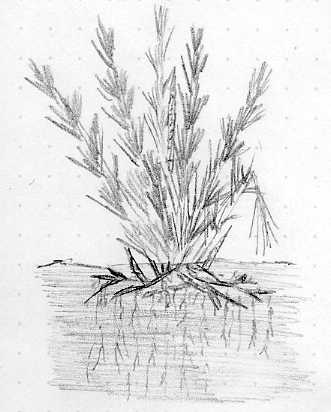

Urian

Name:
Urian
Indigenous:
Gadarren, tropical flatland
Use:
plant fibre, salad greens.
Habit:
Urian is a clump forming perennial which forms dense stands of vegetation
arising from a dense horizontal root network. Though the vegetation can be
impenetratable, the plant itself may only grow to a metre or so tall. Its niche
in Gadarren ecology is similar to grass and covers large areas of lowland where
it is grazed upon by a whole range of animals, and is particularly important for
the large herbivores.
Favoured
conditions: Urian can either grow seasonally or continuously where water is the
major factor. In temperate climes the plant grows slowly and yearlong providing
it has enough water, in drier tropical regions the plant may only grow for half
the year before dying back to the roots.
Structure:
The plantís fronds begin their growth below soil from small buds that lie on
the horizontal root network, these then emerge from the soil as a relatively
undifferentiated conical shoot, as the shoot grows to the fronds full height,
generally about one metre, the frond sprouts thin narrow leaves in a helical
fashion. The horizontal root network lies only a few centimetres beneath the
soil, though a deep set of horizontal roots provides most of the water and
nutrients to the plant.
Foliage:
the emerging shoot consists of two layers, the outer layer becomes finely
dissected as the frond matures and these peel back to give the leaves, the inner
layer forms the stem and the vascular system. The leaves are simple almost
needle like with little other features. The leaves and stems are generally not
perennial, generally dying back in winter to nude, brown stems.
Flowering
and fruits: Urian has very simple flowers, a vestige of the primitive phylum
this plant is part of. The flowering stems emerge in late summer and form
upright erect stems, the height of which varies with species (some possess short
spike below the vegetation, others higher this is perhaps the easiest way to
recognise the two major groups of Urian). The outside of the stem has many pits,
each one of which can develop into a seed case, when first formed the pit hole
is covered by a speck of dew, which serves to collect pollen. In the event of
pollen being captured (wind dispersal is the major route for pollination) the
gametes are fused and seeds are formed. In the event that pollination does not
occur, the cells in the pit develop into pollen, and are released into the wind
once ripe. In successful fertilisation the new zygote encourages the growth of a
coat of cells that block the hole of the pit. The embryo continues to develop
into a small black seed within a fluid filled capsule (as the secreted dew can
not escape), once ripe the pods explosively rupture throwing out seeds.
Cultivation:
Urian is widely grown though its not generally sown, it is treated in a manner
very much similar to pasture. Sometimes fields of Urian are thinned out by
ploughing or fire, and the remaining plants allowed to repopulate the field.
Seed can be harvested as a kind of cereal though this is not a common practice.










